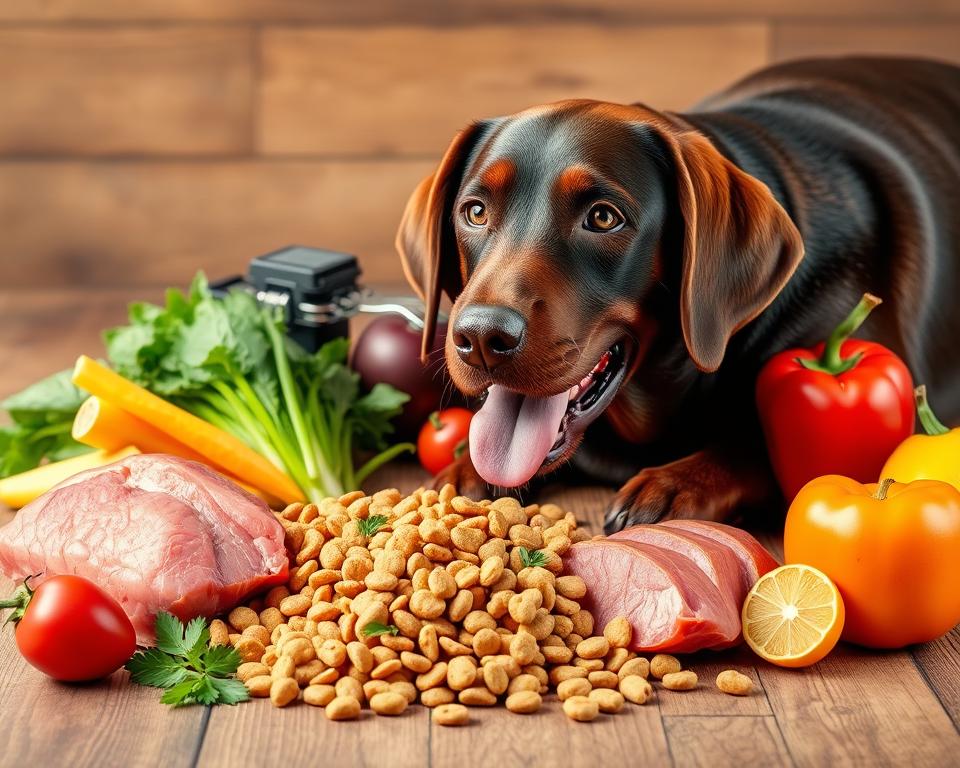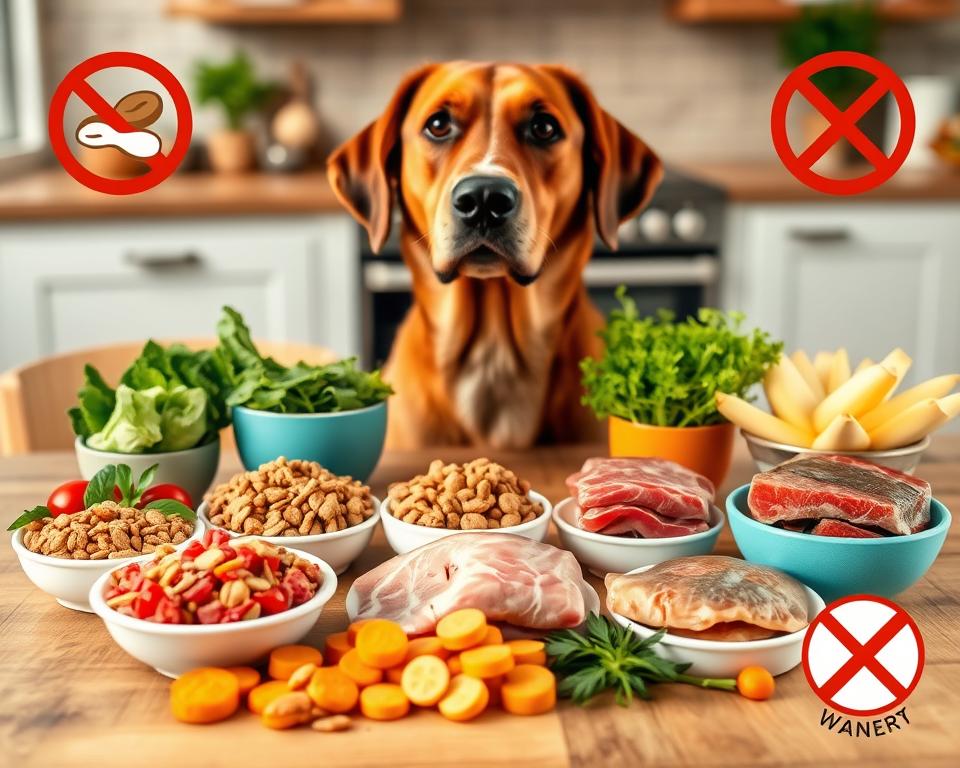Best Diet for Labrador Retriever: Complete Guide 2024
Ensuring our Labrador Retrievers are healthy is very important. They love to eat and can easily get too fat. So, finding the right food for them is a big job for us.
In this guide, we’ll look at what Labradors need to eat. We’ll talk about their special diet needs, the best foods, and how often to feed them. Our goal is to help you make the best food choices for your dog.
Understanding Labrador Retrievers’ Nutritional Needs
Labrador Retrievers need a special diet to stay healthy and happy. They need a balanced diet that meets their active lifestyle. It’s important to focus on the right food at every stage of their life.
A Look at Breed-Specific Requirements
Labrador Retrievers love food high in protein. They do best with real meat like chicken, beef, or fish. They are more likely to get fat, so carbs should be limited to 20% of their diet.
Adults need at least 5% fat, and puppies need 8%. This helps them have energy without getting too heavy.
Key Nutrients for Optimal Health
Labradors need important nutrients for health. They need a good balance of calcium and phosphorus, especially when they’re young. This helps their bones and joints grow strong.
They also need omega-3 and omega-6 fatty acids from fish oil. These keep their skin and fur healthy. Vitamins E and C help their immune system, keeping them healthy for a long time.
Life Stage Considerations
Labrador Retrievers’ dietary needs change as they grow. Puppies need to eat more often, up to four times a day. As they get older, they can eat three times a day, and then two times a day as adults.
Feed them based on their size and how active they are. A 40-45 pound Lab might eat about 205-230 grams of good kibble each day. Eating at regular times helps keep them from getting too fat and prevents bloat.
Types of Dog Food: Which is Best for Labs?
Choosing the right dog food for our Labrador Retrievers is key. There are many options like dry, wet, and raw diets. Each has its own good points and challenges.
Dry Food vs. Wet Food
Dry kibble is a popular choice. It’s easy to use, affordable, and helps keep teeth clean. Eukanuba Complete Dry Dog Food and AVA Breed Health are great picks. They have high-quality proteins that help Labradors stay strong.
Wet food, with more moisture, is good for staying hydrated, especially when our dogs are active. Mixing both can make a balanced diet for our Labs.
Raw Diet Options
Raw dog food, or BARF, uses whole foods. It can make our dogs’ coats shiny and skin healthy. It focuses on natural proteins like chicken and beef.
But, raw diets need careful handling to avoid contamination and ensure they’re balanced. Knowing the risks and benefits is key before switching.
Homemade Diet: Pros and Cons
Homemade dog diets let us control what our Labradors eat. If done right, it can be very healthy. We must make sure to balance proteins, fats, and vitamins.
Without knowing about dog nutrition, homemade diets can be bad. It’s wise to talk to a vet or pet nutritionist to make sure our dogs get what they need.

Recommended Ingredients for Labrador Diets
A good diet for Labradors has many key ingredients. These help keep them healthy and full of energy. High-quality protein is important for their muscles. Carbohydrates and fats also help with digestion and a shiny coat.
Protein Sources
Labradors need good protein. Here are some great sources:
- Chicken: Lean and easy to digest, perfect for muscle maintenance.
- Turkey: A low-fat option rich in essential nutrients.
- Fish: Omega-3 fatty acids from fish support skin and coat health.
- Beef: A robust source of protein and zinc.
Using different proteins makes meals more interesting and nutritious.
Carbohydrates and Fiber
Labradors need healthy digestion. Carbs should be moderate, with fiber-rich veggies added. Good choices include:
- Pumpkin: A fantastic source of fiber that aids digestion.
- Sweet Potatoes: Packed with vitamins, fiber, and low in fat.
- Brown Rice: Easy on the stomach, providing energy without excess calories.
These help with digestion and make meals balanced.
Essential Fats for Healthy Pups
Labradors need fats for skin and coat health. Great sources are:
- Fish oil: Rich in Omega-3 fatty acids to maintain a lustrous coat.
- Flaxseed oil: A plant-based option for obtaining essential fats.
- Chicken fat: A palatable source of energy that supports overall health.
| Ingredient | Benefits | Protein Content (%) |
|---|---|---|
| Chicken | Lean protein and digestible | 30 |
| Fish | Rich in Omega-3 for skin | 25 |
| Pumpkin | Aids digestion | 1 |
| Sweet Potatoes | Rich in vitamins | 2 |
| Flaxseed oil | Plant source of essential fats | 0 |
Common Dietary Restrictions and Allergies in Labs
Labrador Retrievers can have different dietary needs and allergies. Knowing about food allergies in dogs is key for owners. Some foods like beef, chicken, and grains can cause problems. Watch for signs like itching, red skin, or upset stomachs.
Identifying Food Allergies
Finding out if your Lab has a food allergy can be hard. Look for signs like:
- Redness of the inner ears
- Persistent itchiness
- Chronic ear infections
- Ear hematomas
- Thickened skin around the ears
These signs might mean your dog is allergic to foods like beef or chicken. A special diet trial can help figure out what’s causing the allergy.
Limited Ingredient Diets
For dogs with allergies, a simple diet can help a lot. This diet uses fewer ingredients, like one protein and some carbs. It’s less likely to cause an allergic reaction.
Choosing a hydrolyzed food is a good idea. It breaks down proteins so your dog’s immune system doesn’t react to them. This diet can make your dog feel better and healthier.
When to Consult a Veterinarian
If your dog keeps showing signs of an allergy, see a vet. They can do tests to find out what’s causing the problem. They might suggest special diets or other treatments.

| Common Allergens | Symptoms | Recommended Actions |
|---|---|---|
| Beef | Itchy skin, ear infections | Eliminate from diet, monitor symptoms |
| Chicken | Redness, bloating | Switch to hydrolyzed food |
| Wheat | Digestive issues, itching | Start a limited ingredient diet |
| Eggs | Skin irritation | Consult veterinarian for alternatives |
Feeding Schedule: How Often Should You Feed Your Lab?
It’s key to have a good feeding schedule for our Labs. This helps them stay healthy and the right weight. We need to know how much to feed puppies and adult Labs. This keeps them from getting too fat.
Puppies vs. Adult Labs
Puppies need special food because they grow fast. We start with four meals a day. Then, we change to three meals by three months. Finally, adult Labs eat two meals a day.
This change is good for their health and weight.
Portion Control Strategies
Every dog is different, so we must adjust food amounts. Adult Labs need 2 to 4 cups of food a day. We split this into two meals to avoid too much eating.
| Age | Feeding Frequency | Typical Portions |
|---|---|---|
| 8 weeks – 3 months | 4 meals per day | Varies based on food type |
| 3 months – 6 months | 3 meals per day | Varies based on food type |
| 6 months and older | 2 meals per day | 2 to 4 cups (adjust as needed) |
Watching their weight and adjusting food helps. This way, our Labs get the right food. It also helps them grow well and learn good eating habits.
Treats and Snacks: Finding the Right Balance
Treats can make our Labrador’s training better and happier. But, we must pick the right ones. We should avoid treats with too many calories to prevent obesity and health problems. Choosing treats that are full of nutrients helps our dogs stay healthy and fit.
Healthy Treat Options
It’s important to not overdo it with treats. Here are some good choices for our Labs:
- Carrots – Low in calories, high in fiber
- Blueberries – Packed with antioxidants
- Apple slices – Great for dental health
- Sweet potatoes – Nutritious and satisfying
- Commercially available nutritious dog treats – Look for those with limited ingredients
Using Treats for Training
Training treats should be low in calories. This way, we can reward our dogs often without giving them too much. Choose treats that fit your dog’s diet to help them learn without harming their health. A mix of healthy snacks can be a great tool for training.
| Treat Type | Nutritional Benefits | Caloric Content (Approx.) |
|---|---|---|
| Carrots | High in fiber, supports dental health | 41 calories per 100g |
| Blueberries | Rich in antioxidants, good for health | 57 calories per 100g |
| Commercial Treats | Formulated for specific dietary needs | Varies based on brand |
Choosing the right treats for our Labs keeps them healthy and eager to learn. By picking wholesome options, we help our dogs stay happy and healthy.
Special Diets for Weight Management
We know how important it is to keep dogs at a healthy weight. Labradors often get too fat, which can hurt their health. They love to eat, which makes them gain weight easily. So, we need to help them stay slim with special diets and exercise.
Understanding Obesity in Labradors
Being too fat can really hurt a Labrador’s health and happiness. Maxo was very overweight, needing to lose a lot of weight. He started losing weight slowly, with a plan that included special food and exercise.
Recommended Weight Loss Foods
It’s important to pick the right food for dogs trying to lose weight. They need food that’s low in fat and calories but high in protein. Maxo ate special food that helped him lose weight.
| Brand | Key Features |
|---|---|
| Hill’s Science Diet Perfect Weight | High in protein and fiber, enriched with L-carnitine for fat conversion to energy. |
| Purina Pro Plan Weight Management Formula | Contains prebiotic fiber to support digestion and maintain muscle mass during weight loss. |
| Blue Buffalo Homestyle Recipe Healthy Weight | Real chicken as the first ingredient, high in protein, suitable for weight maintenance or loss. |
| Royal Canin Weight Care | Designed for maintaining muscle mass while supporting healthy weight loss. |
Exercise Considerations
Exercise is key when trying to help a dog lose weight. Maxo went for walks or swam for 20 minutes twice a day. He also did fun activities like obedience training. This helped him lose weight and made our bond stronger.
Supplements: Do Labrador Retrievers Need Them?
Labrador Retrievers usually get what they need from a balanced diet. But sometimes, they might need extra help. This is where supplements come in. They can fill in the gaps in their diet or help with health problems.
When to Consider Supplements
There are many reasons to think about supplements for Labradors. Dogs with joint problems, like hip dysplasia, can really benefit. Also, genetic health issues are common in Labradors. For example, about 21% of them need ACL surgery.
Senior dogs also need special care. Supplements can help keep them healthy and full of energy.
Popular Supplements for Labs
There are many supplements that can help our Labradors:
- Omega-3 Fatty Acids: Good for skin, coat, and joints.
- Glucosamine and Chondroitin: Great for joint health, especially for arthritis.
- Probiotics: Boosts digestion and nutrient absorption.
- Antioxidants: Helps prevent diseases, like cancer, which affects 31% of Labradors.
Always talk to a vet before adding supplements to your dog’s diet. They can make sure the supplements are right for your dog. This way, we can keep our furry friends happy and healthy.
Conclusion: Crafting the Perfect Diet for Your Labrador
Creating a diet for our Labradors is a journey. It’s important to do it slowly to avoid upset stomachs. This careful approach helps them stay healthy and happy.
Tips for Transitioning to New Foods
Being consistent is crucial when changing their diet. We need to watch their health and adjust as needed. Things like age and how active they are can affect their diet.
Watching how they react to new foods helps us keep them healthy. This way, they stay full of energy and life.
Monitoring Health and Adjustments
It’s vital to give them a diet full of good stuff. This keeps them healthy and happy for a long time. By paying attention and making changes when needed, we help them stay active and lively.
With careful thought and regular checks, our Labradors can live a happy and healthy life. This sets them up for a bright future.


